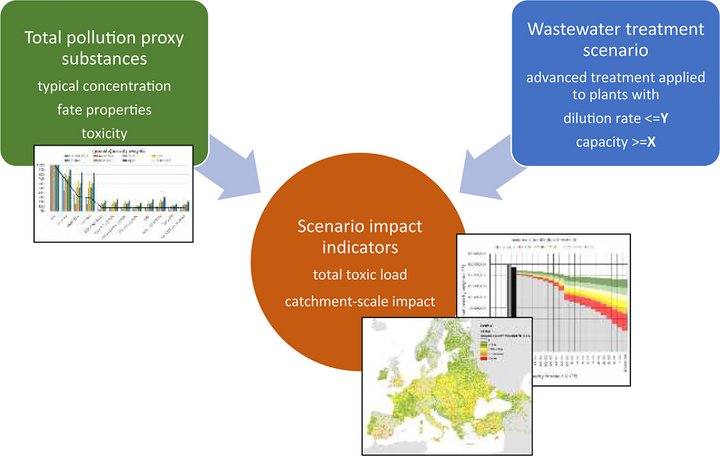Micropollutants (MPs) in wastewater pose a growing concern for their potential adverse effects on the receiving aquatic environment, and some countries have started requiring that wastewater treatment plants remove them to a certain extent. Broad spectrum advanced treatment processes, such as ozonation, activated carbon or their combination, are expected to yield a significant reduction in the toxicity of effluents. Here we quantify the reduction of effluent toxicity potentially achieved by implementing these advanced treatment solutions in a selection of European wastewater treatment plants. To this end, we refer to a list of “total pollution proxy substances” (TPPS) composed of 1337 chemicals commonly found in wastewater effluents according to a compilation of datasets of measured concentrations. We consider these substances as an approximation of the “chemical universe” impinging on the European wastewater system. We evaluate the fate of the TPPS in conventional and advanced treatment plants using a compilation of experimental physicochemical properties that describe their sorption, volatilization and biodegradation during activated sludge treatment, as well as known removal efficiency in ozonation and activated carbon treatment, while filling the gaps through in silico prediction models.
We estimate that the discharge of micropollutants with wastewater effluents in the European Union has a cumulative MP toxicity to the environment equal to the discharge of untreated wastewater of ca. 160 million population equivalents (PE), i.e. about 30 % of the generated wastewater in the EU. If all plants above a capacity of 100,000 PE were equipped with advanced treatment, we show that this load would be reduced to about 95 million PE. In addition, implementing advanced treatment in wastewater plants above 10,000 PE discharging to water bodies with an average dilution ratio smaller than 10 would yield a widespread improvement in terms of exposure of freshwater ecosystems to micropollutants, almost halving the part of the stream network exposed to the highest toxic risks.
Our analysis provides background for a cost-effectiveness appraisal of advanced treatment “at the end of the pipe”, which could lead to optimized interventions. This should not be regarded as a stand-alone solution, but as a complement to policies for the control of emissions at the source for the most problematic MPs.
